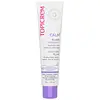What's inside
What's inside
 Key Ingredients
Key Ingredients

 Benefits
Benefits

 Concerns
Concerns

 Ingredients Side-by-side
Ingredients Side-by-side

Water
Skin ConditioningGlycerin
HumectantCoco-Caprylate/Caprate
EmollientHelianthus Annuus Seed Oil Unsaponifiables
EmollientPrunus Domestica Seed Extract
EmollientHydroxyethyl Acrylate/Sodium Acryloyldimethyl Taurate Copolymer
Emulsion StabilisingSilica
Abrasive1,2-Hexanediol
Skin ConditioningEthylhexylglycerin
Skin ConditioningAllantoin
Skin ConditioningO-Cymen-5-Ol
AntimicrobialSorbitan Isostearate
EmulsifyingTocopherol
AntioxidantCitric Acid
BufferingWater
Skin ConditioningHomosalate
Skin ConditioningOctocrylene
UV AbsorberButyl Methoxydibenzoylmethane
UV AbsorberEthylhexyl Salicylate
UV AbsorberCaprylic/Capric Triglyceride
MaskingC12-15 Alkyl Benzoate
AntimicrobialCyclopentasiloxane
EmollientIsononyl Isononanoate
EmollientHydroxyethyl Urea
HumectantCetearyl Alcohol
EmollientPotassium Cetyl Phosphate
EmulsifyingPolyglyceryl-3 Methylglucose Distearate
EmulsifyingGlycerin
HumectantPolymethylsilsesquioxane
Ethylhexyl Triazone
UV AbsorberDiethylamino Hydroxybenzoyl Hexyl Benzoate
UV FilterButylene Glycol
HumectantVincetoxicum Atratum Root Extract
EmollientCornus Officinalis Fruit Extract
Skin ConditioningInulin
Skin ConditioningAlpha-Glucan Oligosaccharide
CleansingTroxerutin
Skin ConditioningMagnolol
AntioxidantHonokiol
AntioxidantPolyglyceryl-10 Laurate
Skin ConditioningPolyglyceryl-6 Oleate
EmulsifyingSorbitan Palmitate
EmulsifyingDimethyl Sulfone
SolventCaffeine
Skin ConditioningRibes Nigrum Seed Oil
EmollientDipotassium Glycyrrhizate
HumectantDiethylhexyl Syringylidenemalonate
Skin ProtectingHydroxyethyl Acrylate/Sodium Acryloyldimethyl Taurate Copolymer
Emulsion StabilisingIsohexadecane
EmollientPolysorbate 60
EmulsifyingXanthan Gum
EmulsifyingParfum
MaskingPhenoxyethanol
PreservativeEthylhexylglycerin
Skin ConditioningChlorphenesin
AntimicrobialTitanium Dioxide
Cosmetic ColorantMica
Cosmetic ColorantTin Oxide
AbrasiveDisodium EDTA
Water, Homosalate, Octocrylene, Butyl Methoxydibenzoylmethane, Ethylhexyl Salicylate, Caprylic/Capric Triglyceride, C12-15 Alkyl Benzoate, Cyclopentasiloxane, Isononyl Isononanoate, Hydroxyethyl Urea, Cetearyl Alcohol, Potassium Cetyl Phosphate, Polyglyceryl-3 Methylglucose Distearate, Glycerin, Polymethylsilsesquioxane, Ethylhexyl Triazone, Diethylamino Hydroxybenzoyl Hexyl Benzoate, Butylene Glycol, Vincetoxicum Atratum Root Extract, Cornus Officinalis Fruit Extract, Inulin, Alpha-Glucan Oligosaccharide, Troxerutin, Magnolol, Honokiol, Polyglyceryl-10 Laurate, Polyglyceryl-6 Oleate, Sorbitan Palmitate, Dimethyl Sulfone, Caffeine, Ribes Nigrum Seed Oil, Dipotassium Glycyrrhizate, Diethylhexyl Syringylidenemalonate, Hydroxyethyl Acrylate/Sodium Acryloyldimethyl Taurate Copolymer, Isohexadecane, Polysorbate 60, Xanthan Gum, Parfum, Phenoxyethanol, Ethylhexylglycerin, Chlorphenesin, Titanium Dioxide, Mica, Tin Oxide, Disodium EDTA
Ingredients Explained
These ingredients are found in both products.
Ingredients higher up in an ingredient list are typically present in a larger amount.
Ethylhexylglycerin (we can't pronounce this either) is commonly used as a preservative and skin softener. It is derived from glyceryl.
You might see Ethylhexylglycerin often paired with other preservatives such as phenoxyethanol. Ethylhexylglycerin has been found to increase the effectiveness of these other preservatives.
Glycerin is already naturally found in your skin. It helps moisturize and protect your skin.
A study from 2016 found glycerin to be more effective as a humectant than AHAs and hyaluronic acid.
As a humectant, it helps the skin stay hydrated by pulling moisture to your skin. The low molecular weight of glycerin allows it to pull moisture into the deeper layers of your skin.
Hydrated skin improves your skin barrier; Your skin barrier helps protect against irritants and bacteria.
Glycerin has also been found to have antimicrobial and antiviral properties. Due to these properties, glycerin is often used in wound and burn treatments.
In cosmetics, glycerin is usually derived from plants such as soybean or palm. However, it can also be sourced from animals, such as tallow or animal fat.
This ingredient is organic, colorless, odorless, and non-toxic.
Glycerin is the name for this ingredient in American English. British English uses Glycerol/Glycerine.
Learn more about GlycerinThis is a synthetic polymer. It helps improve the texture of products by adding thickness and gel-like feel.
It is also an emulsifer, meaning it prevents ingredients such as oil and water from separating. It also helps evenly disperse other ingredients.
Water. It's the most common cosmetic ingredient of all. You'll usually see it at the top of ingredient lists, meaning that it makes up the largest part of the product.
So why is it so popular? Water most often acts as a solvent - this means that it helps dissolve other ingredients into the formulation.
You'll also recognize water as that liquid we all need to stay alive. If you see this, drink a glass of water. Stay hydrated!
Learn more about Water